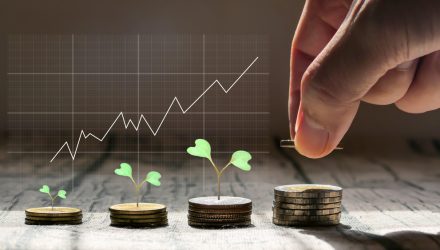Investors seeking future leaders in traditional market sectors can turn to active exchange traded fund strategies to capture these nascent opportunities.
In the recent webcast, Positioning for the Future with Thematic ETFs: A Discussion with Goldman Sachs Asset Management, Marissa Ansell, Lead Client Portfolio Manager For Thematic Investing, Goldman Sachs Asset Management, highlighted five ETF strategies to access long-term secular growth themes that Goldman Sachs Asset Management believes will drive capital markets over the decades ahead, including the Goldman Sachs Future Tech Leaders Equity ETF (GTEK) to invest in future tech leaders down in market cap and outside the U.S.; the Goldman Sachs Future Planet Equity ETF (GSFP) to invest in companies providing solutions to environmental problems; the Goldman Sachs Future Health Care Equity ETF (GDOC) to invest in innovators transforming health care; the Goldman Sachs Future Consumer Equity ETF (GBUY) to invest in companies aligned with changing consumption trends; and Goldman Sachs Future Real Estate and Infrastructure Equity ETF (GREI) to invest in real asset beneficiaries of these secular growth trends.
Brook Dane, Portfolio Manager, Goldman Sachs Asset Management, outlined opportunities in investing toward tomorrow’s technology leaders, such as smart components, cybersecurity, leading-edge semi-cap equipment, consumer internet, digital transformation, fintech, and more. He also noted that most investors are overexposed to U.S. mega-cap tech companies, with the S&P 500 including a 38% tilt toward tech-related companies and the benchmark’s tech components only making up 19% of the total global technology universe.
“We believe there is a disconnect between where most investors are positioned in tech and where we see the most compelling potential opportunities,” Dane said.
Ansell underscored the ongoing climate transition that is creating investment opportunities. For instance, solutions across many different activities are required to address the urgency of climate change, which creates potential investment opportunities in companies developing innovative solutions, such as electric vehicles, single-use plastic substitutions, renewable power, smart cities, water treatment, energy storage, and plant-based protein, among others.
“Extreme weather and geopolitical events have highlighted the scale of the climate emergency, and we believe
companies that offer environmental solutions stand to benefit,” Ansell said.
Dane noted that investing in companies aligned with the evolving consumption trends also helps capitalize on the shift in buying power among the various demographics. Specifically, millennials and generation z demographics now make up the largest population in history, accounting for about 4.9 billion people around the world. Millennials’ incomes have also surpassed that of other generations. These younger consumers are also more digitally savvy.
“Younger consumers have grown up as digital natives and have different lifestyles and values,” Dane said.
Ansell pointed to tech-enabled innovation that has revolutionized the healthcare industry. As the healthcare sector continues to evolve and adapt to the quickly changing landscape, there are a number of potential investment opportunities across multiple fields, such as genomics, precision medicine, digital healthcare, and tech-enabled procedures.
“An unsustainable model is inspiring new solutions that drive better patient outcomes while incurring lower costs. A win for all,” Ansell said.
Lastly, Ansell believed that the future real estate and infrastructure sectors might offer a complementary way for investors to receive exposure to secular growth trends as well. These two segments benefit from some of the above mention growth themes through cell towers, digital storage, utilities enabling the energy transition, renewable energy producers, water utilities, logistics, transportation, leisure hotels, life sciences, and housing, among others.
Furthermore, Ansell highlighted the attractive yields that many real estate and infrastructure companies offer, along with their lower volatility compared to other equity segments.
Dane noted that these strategies are all actively managed and backed by the Goldman Sachs Asset Management team, with well-established thematic managers who have years of experience and cover six geographies worldwide to provide real-time insights into local industries.
The strategies follow a strict bottom-up investment process.
“We focus on growth that we believe is underpriced, as what you pay matters as much as what you buy,” Dane said. “As part of G.S., we get direct access to companies’ CEOs and CFOs. We have less than five percent of our portfolios in unprofitable companies.”
In addition, the portfolios adhere to a disciplined construction methodology.
“We complement high-growth stocks with more value-oriented ideas to help manage risk thoughtfully,” Dane said. “We invest in innovative companies around the world, in developed and emerging markets. With a bias to smaller caps, where we often find compelling investment opportunities.”
Despite the recent drawdowns in the innovative growth segments, Dane argued for the long-term appeal of innovative equities, which offer higher margins and faster earnings growth, which may help justify their premium to the broader equity market.
Moreover, innovative companies may even outperform in the ongoing inflationary environment since innovation helps offset the impact of rising costs, according to Dane. For example, demand is generally inelastic and having best-in-class products helps justify higher prices. Companies also invest in innovation to offset the impact of higher input costs.
Meanwhile, recent global events have further accelerated many of these themes, driving significant investments toward semi-reshoring, energy independence, and healthcare innovation.
In this type of environment, “we believe active management matters more than ever,” Dane said. “Being selective at the stock level and maintaining a balanced portfolio are critical as the market becomes more discerning.”
Financial advisors who are interested in learning more about innovative thematic strategies can watch the webcast here on demand.
